Known for the vibrant-colored flowers that bloom in early spring, primrose is a herbaceous, perennial plant. Buzzle provides information on primrose plant care, ranging from the right planting time to soil, light, and watering requirements.
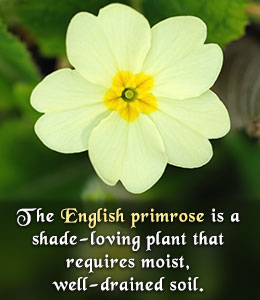
April 19 is observed as the Primrose Day, on the death anniversary of Benjamin Disraeli (1804-1881). As primrose was his favorite flower, his statue is adorned with primroses on this day.The word 'primrose' is derived from the Latin word
primus, which means early or first. The name is certainly apt, as primrose is one of the first flowers to bloom in the spring. The common primrose, which is also called English primrose, is native to several regions of Europe. This plant belongs to
Primula genus and
Primulaceae family. Its scientific name is
Primula vulgaris.
The
Primula genus includes more than 450 species that have flowers in varied colors such as red, purple, yellow, pink, white, bluish-purple, etc. While the common primrose is a wildflower that grows in open woodlands, meadows, and shady banks, gardening enthusiasts who wish to include primrose plants in their garden can opt for cultivars or hybrids derived
Primula vulgaris and
Primula vulgaris subsp. sibthorpii. The hybrid varieties not only come in an array of colors, they could have single or double flowers.
Primula vulgaris and
Primula vulgaris subsp. sibthorpii have received the Royal Horticultural Society Award of Garden Merit. The flowers are a sight to watch. The plant can be kept in pots or used for borders.English Primrose Plant Profile✦
Plant Type: Perennial
✦
Genus: Primula
✦
Species: Vulgaris
✦
Light Requirement: Partial shade
✦
Soil: Moist, acidic, well-drained soil
✦
Bloom Season: Early spring to summer✦
Bloom Color: Yellow
✦
Foliage: Basal rosette of wrinkled leaves
✦
Foliage color: Green
✦
Hardiness: USDA zones 3-9
✦
Height: 20 cm
✦
Spread: 35 cm
✦
Pests: Slugs, snails, spider mitesAs mentioned earlier, the cultivars resulting from crosses between subspecies of common primrose or hybrid varieties are quite popular due to their colorful blooms. Often, these plants are called
Primula x
Polyantha. Their characteristics are given below.✦
Bloom color: Pink, red, orange, yellow, purple, blue or white (the bloom color would vary, depending on cultivar.)
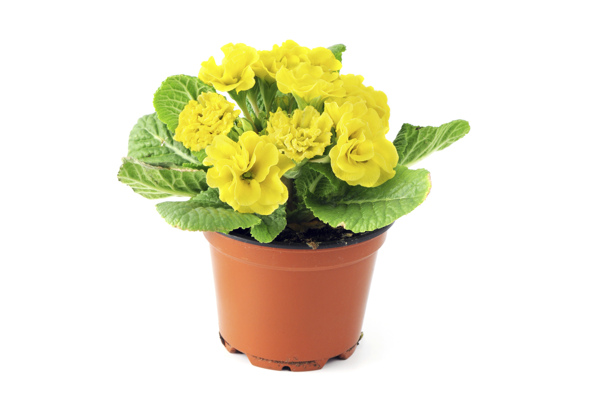
Yellow Primrose
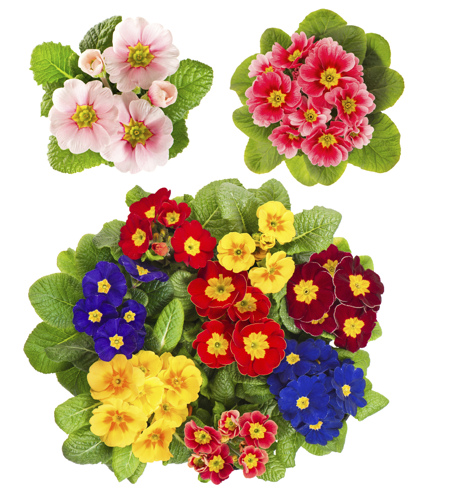
Colorful Polyanthus Primroses
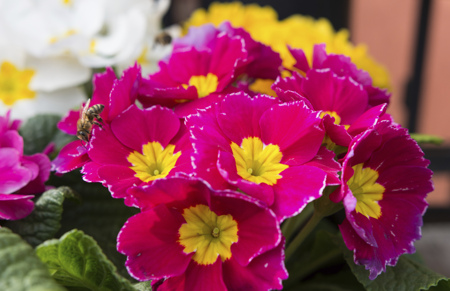
Polyanthus Primrose✦
Habit: Clusters of flowers on the stem
✦
Bloom time: Early to late spring
✦
Length of bloom: 3-4 weeks or more
✦
Height: 6-12 inches
✦
Spread: 8-9 inches✦
Hardiness: USDA zones 3-9
✦
Heat tolerance: AHS heat zones 8-6
✦
Light requirement: Partial shade (full sun in cool climates)
✦
Soil: Humus-rich, moist but well-drained soil
✦
Propagation: Seeds or division after the bloom season in the early springPrimrose is quite popular due to its vibrant-colored flowers and green foliage. It can be planted in borders, beds, pots, containers, or window boxes. You could grow the plant from seeds, or even purchase a plant from the garden center. You can even propagate it by division. Once the bloom season is over, you can dig up the plant, and separate the clumps of rosettes. Each of these can be grown separately in containers or planted outdoors. After primroses stop blooming, dig up the plants and divide.
If you want to keep the plant indoors, it is advisable to opt for the English primrose or
Primula polyantha (hybrid cultivars). It would be best to purchase a plant that has a few flowers and some buds.
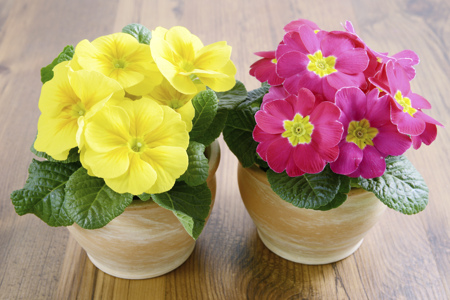
Primrose PlantsIt must be noted that hybrid cultivars are often treated as annuals. Though the hybrid cultivars produce beautiful flowers, they don't last as long as the following varieties:
✦ Common primrose
✦ Cowslip (
Primula veris)
✦ Candelabra primrose (
Primula japonica)
✦ German primrose (
Primula obconica)
✦ Drumstick primrose (
Primula denticulata)
So, choose a variety, depending on your requirements.Tips for Growing Primrose from SeedsIt must be noted that it can sometimes be a little difficult to grow this plant from seeds. If you already have a primrose plant in your home, wait until late summer or early fall to collect the seeds. Store them in a cool, dry place. If you plan to grow this plant from seeds, here's what you need to do:
✦ The seeds can be sown in late spring or early summer. Though they can be sown during warmer periods, you would need to provide them with cold and damp conditions to facilitate germination.
✦ The seeds should be sown in a tray filled with seed compost, while placing them about an inch apart.
✦ Make sure that the seeds are on the surface, and not fully covered by the compost. This will allow them to receive light, which is a requirement for germination.
✦ You can place the tray in a glasshouse or a place with the temperature of 60°F.
✦ With the appearance of seedlings or first true leaves, these can be transplanted into pots. Make sure that the soil is rich in humus and well-drained.
✦ For quicker germination, you could also follow the method of stratification. For that, you need two pieces of damp filter paper. Put the seeds between these papers and roll them. Place this into a polythene bag, which can then be placed in the refrigerator. Make sure that the refrigerator is set at a temperature of around 40°F. After a couple of weeks, check to see if the seedlings have appeared. If yes, then transplant them into a small pot that contains peaty compost. After two weeks, primrose can be planted outdoors. It should be planted after the last frost of spring. However, ensure that the planting site is suitable.Soil Requirements
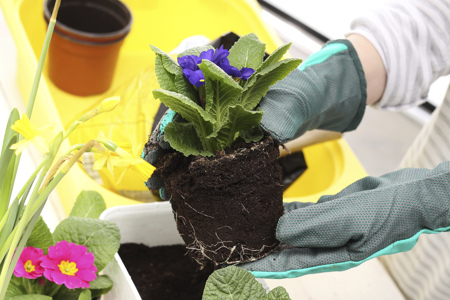
Planting PrimroseAs far as soil is concerned, make sure that it is moist and rich in humus. The soil must be well-drained. Also, it should be slightly acidic or neutral, with a pH between 5.5 and 7. Before planting, you can add peat moss to the soil. A peat-moss based potting mix will allow the soil to retain moisture. If the soil tests suggest that the soil is alkaline, you could add pine needles. Compost can be added if the soil lacks nutrients. A 2-inch layer of mulch can be added for keeping the roots moist. However, it must be changed every year.Light
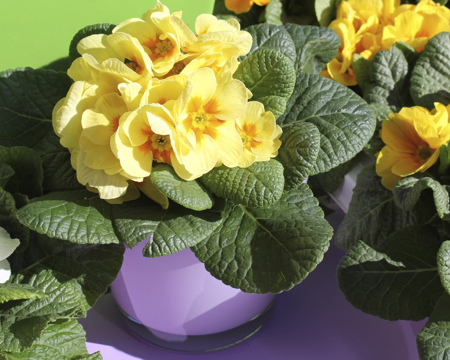
Polyanthus Primrose in Filtered SunlightAnyone who wants to grow a primrose needs to understand that this flowering plant prefers cool temperatures and thrives in partially-shaded areas. So, if you live in a warm inland region, don't plant in an area that receives direct sunlight for a long time. In certain cooler regions, it can tolerate full sunlight. If the plant is placed in a pot or container, you can put it in an area that receives filtered light.WateringThe soil should be moist. Though watering the plant too often can increase the risk of root rot, make sure that the soil is never dry. It should remain evenly moist. Excessive watering can cause the leaves to turn yellow, while dry soil can lead to wilting of the leaves.FertilizerPrimroses should be fertilized regularly. You can replenish the soil in early spring, before the new growth. You can use a 10-10-10 ratio fertilizer. Make sure that you apply the fertilizer after removing the layer of mulch that you added in the previous year. In case of a houseplant, you could use a half-strength house plant fertilizer solution. This can be applied once a month. For primrose that has been planted outdoors, a light application of general garden fertilizer every month might be required. Do not fertilize in the bloom season.DiseasesThe infestation of slugs, snails, spider mites, and aphids can cause damage to the plant. So, watch out for signs of an infestation. Do apply a natural pesticide to avoid and control an infestation. If the plant gets affected by leaf spot disease, make sure that you remove the diseased leaves. Like most plants, excess watering can lead to root rot. So, water the plant properly.PruningPruning is extremely important. In order to encourage profuse flowering, make sure that you remove the spent or faded flowers. Also, remove the dead leaves.Any gardening enthusiast who has seen the English primrose or polyanthus primrose flowers knows how these flowers can significantly add to the beauty of any flower garden. Flowers from the Primula genus are breathtakingly beautiful. To be able to grow them in your garden, all you need to do is provide them with the ideal growing conditions. So, keep the aforementioned primrose plant information and growing tips in mind, and be ready to get mesmerized in the flowering season!






 April 19 is observed as the Primrose Day, on the death anniversary of Benjamin Disraeli (1804-1881). As primrose was his favorite flower, his statue is adorned with primroses on this day.The word 'primrose' is derived from the Latin word primus, which means early or first. The name is certainly apt, as primrose is one of the first flowers to bloom in the spring. The common primrose, which is also called English primrose, is native to several regions of Europe. This plant belongs to Primula genus and Primulaceae family. Its scientific name is Primula vulgaris.
April 19 is observed as the Primrose Day, on the death anniversary of Benjamin Disraeli (1804-1881). As primrose was his favorite flower, his statue is adorned with primroses on this day.The word 'primrose' is derived from the Latin word primus, which means early or first. The name is certainly apt, as primrose is one of the first flowers to bloom in the spring. The common primrose, which is also called English primrose, is native to several regions of Europe. This plant belongs to Primula genus and Primulaceae family. Its scientific name is Primula vulgaris. Yellow Primrose
Yellow Primrose Colorful Polyanthus Primroses
Colorful Polyanthus Primroses Polyanthus Primrose✦ Habit: Clusters of flowers on the stem
Polyanthus Primrose✦ Habit: Clusters of flowers on the stem Primrose PlantsIt must be noted that hybrid cultivars are often treated as annuals. Though the hybrid cultivars produce beautiful flowers, they don't last as long as the following varieties:
Primrose PlantsIt must be noted that hybrid cultivars are often treated as annuals. Though the hybrid cultivars produce beautiful flowers, they don't last as long as the following varieties: Planting PrimroseAs far as soil is concerned, make sure that it is moist and rich in humus. The soil must be well-drained. Also, it should be slightly acidic or neutral, with a pH between 5.5 and 7. Before planting, you can add peat moss to the soil. A peat-moss based potting mix will allow the soil to retain moisture. If the soil tests suggest that the soil is alkaline, you could add pine needles. Compost can be added if the soil lacks nutrients. A 2-inch layer of mulch can be added for keeping the roots moist. However, it must be changed every year.Light
Planting PrimroseAs far as soil is concerned, make sure that it is moist and rich in humus. The soil must be well-drained. Also, it should be slightly acidic or neutral, with a pH between 5.5 and 7. Before planting, you can add peat moss to the soil. A peat-moss based potting mix will allow the soil to retain moisture. If the soil tests suggest that the soil is alkaline, you could add pine needles. Compost can be added if the soil lacks nutrients. A 2-inch layer of mulch can be added for keeping the roots moist. However, it must be changed every year.Light Polyanthus Primrose in Filtered SunlightAnyone who wants to grow a primrose needs to understand that this flowering plant prefers cool temperatures and thrives in partially-shaded areas. So, if you live in a warm inland region, don't plant in an area that receives direct sunlight for a long time. In certain cooler regions, it can tolerate full sunlight. If the plant is placed in a pot or container, you can put it in an area that receives filtered light.WateringThe soil should be moist. Though watering the plant too often can increase the risk of root rot, make sure that the soil is never dry. It should remain evenly moist. Excessive watering can cause the leaves to turn yellow, while dry soil can lead to wilting of the leaves.FertilizerPrimroses should be fertilized regularly. You can replenish the soil in early spring, before the new growth. You can use a 10-10-10 ratio fertilizer. Make sure that you apply the fertilizer after removing the layer of mulch that you added in the previous year. In case of a houseplant, you could use a half-strength house plant fertilizer solution. This can be applied once a month. For primrose that has been planted outdoors, a light application of general garden fertilizer every month might be required. Do not fertilize in the bloom season.DiseasesThe infestation of slugs, snails, spider mites, and aphids can cause damage to the plant. So, watch out for signs of an infestation. Do apply a natural pesticide to avoid and control an infestation. If the plant gets affected by leaf spot disease, make sure that you remove the diseased leaves. Like most plants, excess watering can lead to root rot. So, water the plant properly.PruningPruning is extremely important. In order to encourage profuse flowering, make sure that you remove the spent or faded flowers. Also, remove the dead leaves.Any gardening enthusiast who has seen the English primrose or polyanthus primrose flowers knows how these flowers can significantly add to the beauty of any flower garden. Flowers from the Primula genus are breathtakingly beautiful. To be able to grow them in your garden, all you need to do is provide them with the ideal growing conditions. So, keep the aforementioned primrose plant information and growing tips in mind, and be ready to get mesmerized in the flowering season!
Polyanthus Primrose in Filtered SunlightAnyone who wants to grow a primrose needs to understand that this flowering plant prefers cool temperatures and thrives in partially-shaded areas. So, if you live in a warm inland region, don't plant in an area that receives direct sunlight for a long time. In certain cooler regions, it can tolerate full sunlight. If the plant is placed in a pot or container, you can put it in an area that receives filtered light.WateringThe soil should be moist. Though watering the plant too often can increase the risk of root rot, make sure that the soil is never dry. It should remain evenly moist. Excessive watering can cause the leaves to turn yellow, while dry soil can lead to wilting of the leaves.FertilizerPrimroses should be fertilized regularly. You can replenish the soil in early spring, before the new growth. You can use a 10-10-10 ratio fertilizer. Make sure that you apply the fertilizer after removing the layer of mulch that you added in the previous year. In case of a houseplant, you could use a half-strength house plant fertilizer solution. This can be applied once a month. For primrose that has been planted outdoors, a light application of general garden fertilizer every month might be required. Do not fertilize in the bloom season.DiseasesThe infestation of slugs, snails, spider mites, and aphids can cause damage to the plant. So, watch out for signs of an infestation. Do apply a natural pesticide to avoid and control an infestation. If the plant gets affected by leaf spot disease, make sure that you remove the diseased leaves. Like most plants, excess watering can lead to root rot. So, water the plant properly.PruningPruning is extremely important. In order to encourage profuse flowering, make sure that you remove the spent or faded flowers. Also, remove the dead leaves.Any gardening enthusiast who has seen the English primrose or polyanthus primrose flowers knows how these flowers can significantly add to the beauty of any flower garden. Flowers from the Primula genus are breathtakingly beautiful. To be able to grow them in your garden, all you need to do is provide them with the ideal growing conditions. So, keep the aforementioned primrose plant information and growing tips in mind, and be ready to get mesmerized in the flowering season!